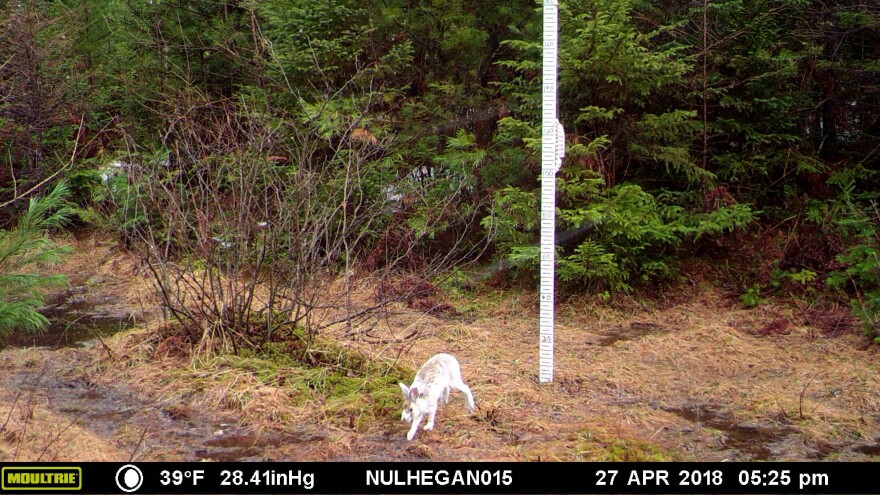On a recent warm spring day in New Hampshire’s White Mountains, wildlife biologist Alexej Siren found something exciting: snowshoe hare tracks in a fleeting patch of snow.
“We have these larger hind feet that are out to the side like that, and then the smaller front feet that are behind it,” he said, demonstrating how the animals hop to avoid predators.
It took a tricky bushwhack up and over downed trees and through a bog to get to this place, but we were standing in what Siren said is prime snowshoe hare habitat.
Snowshoe hares change their fur with the seasons and the snow. In the summer they’re generally brown; in the winter they’re white.

But as New England sees less and less snow due to human-caused climate change, some so-called “mismatched” hares are sticking out like sore thumbs.
Siren is part of a coalition of New England researchers that are studying two ideas about how to help, which brings us to the White Mountains.
This little patch of older forest is full of blow-downs, and waist-high spruce and fir trees are growing up in the space the older trees have left behind.
It’s dense and difficult to navigate because it’s hard to see your feet.

Snowshoe hares like to nibble on the protein-rich buds of young hardwoods, but especially spruce and fir. These 10- 15-year-old saplings have low, dense boughs that help the hares hide from predators.
The small trees also create shade and hold onto snow, so the hares can camouflage.
Siren has been tracking snowshoe hare populations in New England for more than a decade, sometimes by catching and tagging the animals, sometimes by counting their pellets on the forest floor. The purpose of this trip was to check some game cameras.
Snowshoe hares have light bones and big feet that make them specially adapted to life on the snow, but their ability to camouflage is also critical to their survival.
“They're one of the few color molting species in the world that actually change their seasonal coats from to be brown in the summertime to white in wintertime, to be camouflaged with snow,” Siren said.
However, when the hares are "mismatched" with their surroundings, they lose their ability to camouflage.

“The classic when we think of them being mismatched is when they're white and there's no snow on the ground,” Siren said. “They've been shown to have higher rates of predation during those time frames.”
But there’s hope for these animals. Siren says in places like West Virginia, Pennsylvania and even southern Maine, scientists have found snowshoe hares that no longer turn white in the winter.
He has a grant now to study whether introducing some of those hares to New England could help the animals here adapt to climate change — a solution scientists call “assisted migration.”
“It's a complicated solution in one way, because it's challenging to move animals across geopolitical borders,” he said. “So it's challenging to move them from one state to another. There are also risks to translocations.”
Some of those risks include taking too many of the limited brown hares from the source population, such that the trait dies out there, or putting the precious brown hares in a place where they won’t thrive.
Siren hopes this assisted migration could become a viable solution in the next decade or so.
In the meantime, researchers at the University of Vermont are looking at another fix in the forest itself.

“We can actually influence snow behavior a bit by changing the nature of the forest canopy and trying to create conditions where it accumulates and also melts slower than other spots,” said Tony D’Amato, who leads the forestry program at the University of Vermont.
Snowshoe hares love what’s called “early successional forest” — those small trees that crop up after a big wind storm, or in the wake of logging.
But D’Amato research on recovering paper lands in northern Vermont’s Nulhegan Basin and the Umbagog Wildlife Refuge in New Hampshire and Maine has shown that big clear cuts aren’t the answer here.
“What we found is that, you know, those smaller openings with shade around them really do accumulate and actually maintain snow a lot longer,” he said.

In some places, this can be achieved by protecting existing old forests, which go through natural cycles of growth and disturbance because of the weather.
However, those ecosystems are fairly rare in New England, especially on the region’s private lands.
D’Amato hopes harvesting trees from tiny patches of land here and there — say a tenth of an acre — and leaving a lot of the wood behind, can help keep snow on the ground for longer and create the ecosystems that keep the hares safe.
This research is about five years old, and it will take decades to see the full impact. But the early results are promising, he said.
“We're seeing, on average, over that winter period, up to a foot more snow in those places, and in some times even greater,” said D’Amato.

Part of D’Amato’s research involved working with commercial logging operations to test the economic viability of doing this sort of work as part of a timber sale.
He said this is a solution that small landowners could ask their forester to put into practice on their land now.
And that’s important for it to be scalable, because outside of public lands, he said, “The only way this work is getting done is that somebody is able to financially pull this off.”
Back in the woods in New Hampshire, Alexej Siren says finding a solution for the hares is about more than saving this culturally significant and charismatic creature.
“They're a really important, number one species, a primary species of boreal ecosystems,” Siren said. “And if you didn't have them there, then these ecosystems would collapse.”
It’s something both researchers are fighting to prevent.




